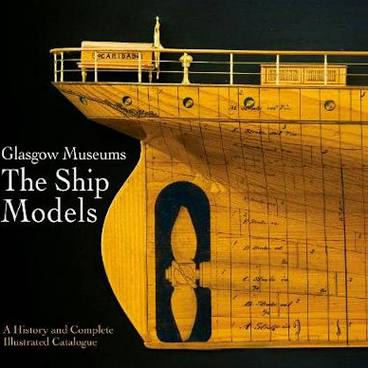

Glasgow Museums – The Ship Models. A History and Complete Illustrated Catalogue. Emily Malcolm & Michael R Harrison. Seaforth Publishing, Barnsley, 2019.
Reviewed by David Hobbs
This beautifully produced book was published in co-operation with the Glasgow Museums with the intention of both illustrating and giving background information about their remarkable collection of over 600 ship models. The majority represent ships built on the Clyde between the late eighteenth and early twenty-first centuries and the collection as a whole is an important international resource for the study of shipbuilding as well as being a delight for generations of model-makers and collectors.
Emily Malcolm is a curator of Transport and Technology at the Glasgow Museums who has worked extensively with maritime collections throughout Scotland. Michael R Harrison is the Obed Macy Director of Research and Collections at the Nantucket Historical Association where he previously served as chief curator. Prior to that he had held curatorial positions in the Smithsonian’s National Museum of American History and in the Glasgow Museums. Together they bring considerable knowledge and an international aspect to this work.
The Ship Models is more than just a listing of models with photographs of every one. A total of 145 out of the 359 pages before the extensive chapter notes and index are taken up with well illustrated text which explains how models were used by shipbuilders in the design and development stages of the ships they portray. Some were used by shipyard pattern shops to work out how best to make individual structures such as hull frames, and to work out the arrangement of rigging, piping and ducting. Others, especially the half-hull wooden models, were used to work out the best arrangement of hull plating to minimize waste and ensure that orders could be placed with iron and steel suppliers for appropriately-sized plates in the right quantities. Models were also used by shipbuilders to test the hydrodynamic qualities of hull design and these are described together with the water tanks in which they were tested. The most impressive models of all, however, are those produced by shipbuilders for display, literally to show potential customers miniature versions of the full-sized ships that their money could buy. Many of these are shown in full-page photographs which show fine details to the best advantage.
The second half of the book contains coloured photographs of every model, brief descriptions of the ship that they portray and the model’s catalogue number for reference. They range from small boats, a Viking longship and sailing ships made out of bone by French prisoners during the Napoleonic Wars to the largest liners including the famousQueen Mary and Queen Elizabeth by way of merchant ships, warships, dredgers, yachts and ferries. Many, but by no means all, were built for British owners and many will be familiar to ANI members. Several of the models depict merchant ships that were torpedoed and sunk during the two world wars and the majority are to 1:96 or 1:48 scale which allowed the incorporation of considerable detail.
Overall this is an impressive book but it is difficult to judge the number of potential readers who would want to own it rather than simply study it in a library or archive. Large, and weighing an impressive 2.6 kg it needs a sturdy bookshelf but it should certainly appeal to anyone with an interest in the evolution of the shipbuilding industry, model-makers and those who, like me, are fascinated by model ships. It should also attract readers with an interest in the history of ships. Where else could you find a colour photograph of a model Egyptian Government non-propelled cutter-suction dredger designed to cut in a radial arc with a sideways discharge pipe and 3 ‘spuds’ for anchoring and positioning? It is on page 307. The publisher’s recommended retail price is very reasonable given the quality of the images and I can certainly recommend this book.



